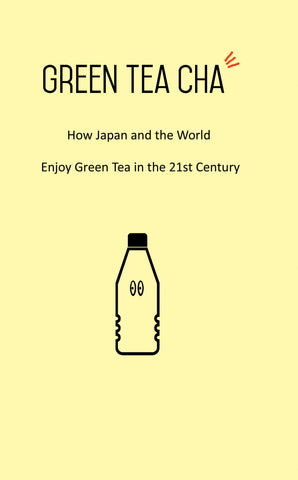Subscribe to Green Tea Podcast:
Vending Machine Culture and Green Tea Trend in Japan
Japan loves its vending machines (known as jidōhanbaiki 自動販売機, or jihanki for short 自販機) and its green tea, so it's no wonder the combination of both is a hot trend across the country. The Japan Vending Machine Manufacturers Association notes that there is roughly one vending machine for every 23 people; this means there are more vending machines per capita in Japan than in any other country. Surprisingly, even Buddhist temples have vending machines that sell amulets.
Green tea, in its multitude of forms, is the most commonly sipped beverage in the country. Hot or cold, green tea fuels Japanese society in a number of ways, and one of the most popular means is through countless vending machines that stand like ready-to-serve sentinels throughout the country. In fact, vending machines that sell green tea, whether hot or cold, are located not only on nearly every street corner, but down alleyways, and in train stations too.

In a nation with an unquenchable thirst for green tea (ryokucha), the vending machine is a perfect partner for doling out Japan's most-consumed drink whether it's Sencha, Matcha, Kukicha, or another iteration of green tea, it's a sure bet you will find your favorite combination at a vending machine regardless of whether you are visiting Tokyo, Osaka, or Sapporo. However, if you are in the mood for hot green tea, keep in mind you are more likely to find it in vending machines during the winter rather than the summer since the demand for hot tea changes according to the season.
The trend in readily available green tea from a myriad of vending machines all over Japan is a great fit for the country's busy society. It serves Japanese culture well because, as columnist Harrison Jacobs of Business Insider notes, it's common knowledge that Japan is famous for a hard-working society where jobs take up much of its time. Thus, the need for a quick, green tea pick-me-up means taking only a few moments to feed a yen note into a machine, grabbing your tea, and heading off to the next business meeting. This is preferable in Japan's busy society than lingering in a shop waiting for tea to be prepared.
Jacobs also mentions that Japanese culture is comfortable with automation and is usually on the cutting edge, developing evolved high-tech machines. This too fits with Japan's need for convenience and ease when it comes to products – especially its craving for green tea.
Massive consumption of green tea from vending machines spans the country as 2.5 billion green tea containers are sold in Japan every year. The Japan National Tourism Organization estimates those billions of containers means that Japan gulps down vending machine green tea to the tune of about 6.95 trillion yen annually, and most machines accommodate coins, bills, various yen notes, and IC cards, such as Suica, Kitaca, Icoca, and Pasmo, among others.
When it comes to grabbing a bottle or a can of green tea from a vending machine, people in Japan have a large selection to choose from. Different green tea drinks include Genmaicha (green tea with brown rice), Gyokuro, Hojicha (roasted green tea), Matcha, Tencha, and Sencha, which is the most popular type of green tea in Japan. If there is a type of green tea that can be bottled or put into a can, you will find a machine that serves it.
Japan's Vending Machines not Only Deliver Green Tea, but Say “Thank You” in Japanese
Vending machine culture, and the green tea trend in Japan show no sign of slowing down. In fact, you can probably expect automated machines to become more high tech and consumer-friendly in the future. Not that they aren't already friendly to those who patronize them; after all, some jidōhanbaiki offer a spoken “thank you” once your order has been delivered. Politeness is a characteristic in Japanese culture, and manners even extend to vending machines! As Kontaku.com noted in an article, some jihanki (a shorter reference for vending machine) even update you on current events or the weather.
A History of Unmanned Sellers
Part of Japan’s history with jihanki has to do with the country’s post-World War II rebuilding efforts. Throughout the 1940s, jihanki gave Japanese consumers quick, easy access to the food goods they needed throughout their day and kept operating costs low for food sellers. A related tradition is the “unmanned seller,” which describes fruit and vegetable stands, often in the Japanese countryside, at which customers pay and pick their produce without interacting with a vendor. Low operating costs for food vendors helped consumers get more value for their food money.
Low Crime Rate and Vending Machine
Japan’s low crime rate is another factor in its vending machine culture. Unmanned sellers were, and still are, unlikely to be stolen from. Likewise, Japanese citizens are quite unlikely to vandalize or attempt to rob jihanki.
Jihanki continued to gain popularity in the 1960s when Japan’s population expanded and its infrastructure grew. Access to vending machines became part of everyday life, and Japanese citizens became familiar and comfortable with jihanki, eventually growing to expect them. Because the vending machines are generally kept in good working order and are rarely vandalized, consumers trust that the food, cigarettes, and drinks offered by the machines are safe to consume.

The Many Drink Makers
In addition, Japan is also home to a large number of soft drink manufacturers. Jihanki serve as point-of-purchase advertising for beverage companies like Asahi, Calpis, Ito En, Kirin, Pokka Sapporo, and Suntory. Each company crafts its vending machine to be eye-catching, and to be branded with the company’s unique visual language. Consumers just have to glance at the machine to know what kind of drinks to expect.
However, unlike in the United States where vending machines are associated with unhealthy drinks full of sugar, artificial colors, excessive sodium, and empty calories, jihanki tend to serve healthy beverages. Japanese consumers often choose healthy drinks such as water, mineral water, plum juice, coffee, and unsweetened green tea over sugar-laden sodas and energy drinks; of course, U.S.-based brands such as Coca Cola, Dr. Pepper, Minute Maid, and Fanta do also take a share of the Japanese vending machine market.
Green Tea Vending Machines
Some jihanki specialize in green tea; you can spot these by the tea theme of the machine, which might include the kanji character for “tea” written all over the outside of the vending machine. Japanese tea beverages are served unsweetened, and without sugar or sugar substitutes with the exception of black teas which are available from jihanki with sugar and milk, the way black tea is often served in Europe.
2.5 billion green tea cans are sold in Japan per year. Many brands, including Oi Ocha (which translates into English as “Hey, tea”), opt to package their products in transparent plastic bottles that allow consumers to see the green color of the tea. The labels of these bottles are often green themselves and depict leaves. This design makes the tea appear refreshing, but also makes many of the tea brands look almost identical.

Ito En, the maker of Oi Ocha, was the Japanese company that first introduced bottled green tea in vending machines. The traditional tea company introduced cans of sencha green tea in 1985 and followed up with bottled Oi Ocha in 1989. Oi Ocha is the most popular bottles green tea in Japanese vending machines.
The Coca-Cola company’s bottled green tea brand is called Ayataka, which earns the manufacturer over $1 billion in sales per year. Coca-Cola developed its green tea flavor in partnership with Kanbayashi Shunsho, a traditional tea maker based in Kyoto.
Read on - Click here to read about Major Green Tea Manufactures in Japan
Above is part of a chapter from my recent book: Green Tea Cha : How Japan and the World Enjoy Green Tea in the 21st Century
Please Click Below Image to Get My Book Green Tea Cha : How Japan and the World Enjoy Green Tea in the 21st Century from Amazon (Both Printable Format and Kindle Version Available)
Language: English
ISBN-10: 1546704418
ISBN-13: 978-1546704416
Product Dimensions: 5.5 x 0.4 x 8.5 inches
Shipping Weight: 9 ounces
Kei Nishida is back with his latest book on the subject of Green Tea, Green Tea Cha, How Japan and the world Enjoys Green Tea in the 21st Century. In this 143 page book Tokyo native Nishida covers the changing use and appreciation for tea in the 21st Century. He brings together a collection of facts and observances that allows the reader to peer into the cultural mindset of those who enjoy Green Tea. He begins by explaining how tea is enjoyed in Japan today and the merger of traditional Japanese culture with that of the jihanki (vending machines) and ends with a discussion of Green Tea Beverages that “you’ve never heard of before but are drop dead delicious.” Each chapter brings together a plethora of information about the uses of Green Tea in his pleasant, informative style, encouraging the reader to seek out these drinks and dishes for themselves. By the end of the book readers will not only have a list of “must try” drinks and dishes but also an appreciation for this powerful, tasty antioxidant.
Click Here to Get This Book On Amazon Now
Get Free Bonus Books

Sign up for free to the Green Tea Club to get advice and exclusive articles about how to choose Japanese Tea, and tips, tricks, and recipes for enjoying Japanese tea.
About the author
Kei Nishida
Author, CEO Dream of Japan
Certification: PMP, BS in Computer Science
Education: Western Washington University
Kei Nishida is a Japanese green tea enthusiast, a writer, and the founder and CEO of Japanese Green Tea Co., a Dream of Japan Company. His passion for introducing America to the tea of his homeland was the catalyst for creating the only company that brings high-quality tea from Arahataen Green Tea Farms to the rest of the world. Learn more about Kei























